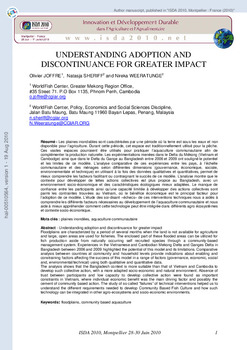Understanding adoption and discontinuance for greater impact
Abstract
Floodplains are characterized by a period of several months when the land is not available for agriculture and large, open areas are used for fisheries. The enclosed part of these flooded areas can be utilized for fish production aside from naturally occurring self recruited species through a community-based management system. Experiences in the Vietnamese and Cambodian Mekong Delta and Ganges Delta in Bangladesh between 2006 and 2009 highlighted the potential of this model and its limitations. Comparative analysis between countries at community and household levels provide indications about enabling and constraining factors affecting the success of this model in a range of factors (governance, economic, social and, environmental/technical) using both qualitative and quantitative data. The analysis shows that the Bangladesh context is more suitable than that of Vietnam and Cambodia to develop such collective action, with a more adapted socio-economic and natural environment. Absence of trust between participants and low capacity to develop collective action were found as important constraints in Vietnam, where individual economic benefit was the main driving factor and possibly the cement of community based action. The study of so called “failures” of technical interventions helped us to understand the different requirements needed to develop Community Based Fish Culture and how such technology can be integrated in other agro-ecosystems and socio-economic environments

